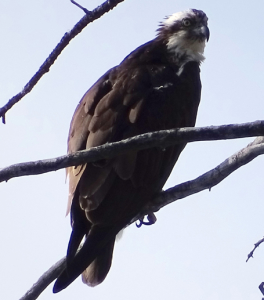Winter Survival in Grand Teton and Yellowstone High Mountains
One adaptation for animals to live the Grand Teton and Yellowstone high mountain area in the wintertime is migration, or moving from one area to another for survival.
In the greater Yellowstone/ Grand Teton ecosystem, winter is a great challenge to wildlife. Daylight hours are short, temperatures are mostly below freezing, and food is scarce. Typically, from November through May the entire landscape is covered with snow, making movement and finding food very challenging. As such, animals and other wildlife have evolved to cope.
Geographic Migration (Changing Your Latitude)
 Let’s start by observing our feathered friends – birds. For some birds, like the osprey or mountain bluebird, flying to warmer southern regions is the solution. This is called geographic migration. Osprey live off of catching fish and have a success rate of about 70% per dive. In winter, most lakes and rivers are frozen over, not allowing the osprey to fish. GPS tracking collars show these birds flying as far south as Cuba to survive. This is similar to some of our grandparents who spend summers in New England and winters in Florida and California.
Let’s start by observing our feathered friends – birds. For some birds, like the osprey or mountain bluebird, flying to warmer southern regions is the solution. This is called geographic migration. Osprey live off of catching fish and have a success rate of about 70% per dive. In winter, most lakes and rivers are frozen over, not allowing the osprey to fish. GPS tracking collars show these birds flying as far south as Cuba to survive. This is similar to some of our grandparents who spend summers in New England and winters in Florida and California.
Vertical Migration (Changing Your Elevation)
 For animals that cannot fly, like bison, mule deer, elk, and pronghorn antelope, the answer is vertical migration- coming down from the higher mountain valleys into lower valley elevations, where less snow makes it easier to find food.Take the pronghorn antelope of Grand Teton National Park, for example. In late October, these very fast, short-height ungulates will cross the Gros Ventre Mountains southeast toward Colorado, sometimes over a 150+ mile distance, to find areas of little snow and food. If the pronghorn herd gets snowed in or the route is blocked and the animals are not able to cross the mountain passes, their survival is extremely difficult. Predators like coyotes and wolves take advantage of deep snow depths which slow the short-legged antelope, making them easier to catch.
For animals that cannot fly, like bison, mule deer, elk, and pronghorn antelope, the answer is vertical migration- coming down from the higher mountain valleys into lower valley elevations, where less snow makes it easier to find food.Take the pronghorn antelope of Grand Teton National Park, for example. In late October, these very fast, short-height ungulates will cross the Gros Ventre Mountains southeast toward Colorado, sometimes over a 150+ mile distance, to find areas of little snow and food. If the pronghorn herd gets snowed in or the route is blocked and the animals are not able to cross the mountain passes, their survival is extremely difficult. Predators like coyotes and wolves take advantage of deep snow depths which slow the short-legged antelope, making them easier to catch.
Elk, deer and bison have similar migration routes which are crucial for their winter survival. If migration routes are blocked, animals die. One solution to blocked migration routes that humans have created is the National Elk Refuge. This is basically a 25,000 acre reserve (feedlot), where during the winter, elk, bison and mule deer are fed, due to blockage of historical migration routes through the town of Jackson. Thousands of animals arrive each winter.
Subnivean Survival (Under the Snow)
 Another type of winter survival is subnivean, or life below the snow. Some animals, like moles, voles and pikas (small mammals with big, round ears related to rabbits), live below the ground, creating a barrier between above-ground predators and insulation from cold winter temperatures.During the summer months, these small animals busy themselves storing caches of food below ground. Once the snow and winter temperatures have arrived, they dig in for the long months below ground and survive off their summer food storage.The key idea is that in order to survive in the Greater Yellowstone winter, wildlife migration (moving from one area to another) is a winter survival adaptation.
Another type of winter survival is subnivean, or life below the snow. Some animals, like moles, voles and pikas (small mammals with big, round ears related to rabbits), live below the ground, creating a barrier between above-ground predators and insulation from cold winter temperatures.During the summer months, these small animals busy themselves storing caches of food below ground. Once the snow and winter temperatures have arrived, they dig in for the long months below ground and survive off their summer food storage.The key idea is that in order to survive in the Greater Yellowstone winter, wildlife migration (moving from one area to another) is a winter survival adaptation.




